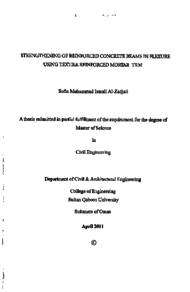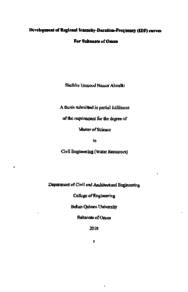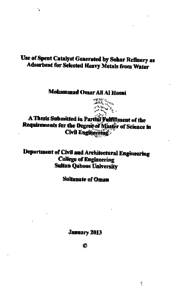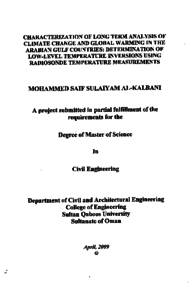Document
Ions transport behavior in microbial desalination cell and its effect on electricity recovery and waste removal.
Publisher
Sultan Qaboos University
Gregorian
2018
Language
English
English abstract
The rapid urbanization and economic growth around the world creates a higher demand of freshwater and energy. Both the water and energy supplies are costly and unsustainable due to over utilization and inadequate technology. Seawater desalination is one of the largest supplier of freshwater in water scarcity regions. However, all the recently developed desalination technologies (Reverse Osmosis, Thermal distillation, thermal desalination, etc.) are energy intensive due to operate with high mechanical pressures or heat evaporation. That why, there is a need of cost effective, sustainable and eco-friendly desalination technology. Microbial desalination cell (MDC) is an environmental friendly method that could be considered as cost-effective substitution to the currently available desalination methods. MDC is a new technology of producing of electricity by bacterial biofilm on anode. Such bacterial biofilms oxidized organic matters as their food and produced electrons and protons (H+). This produced electricity and cell potential induced the migration of salt ions from desalination chamber. Due to limited information available for using real seawater, this study was carried out to investigate ions transportation mechanisms and rates using real seawater to improve desalination efficiency for real applications. In this study, three different salt solutions with same electrical conductivity (EC) 55.4 ms/cm (similar EC of real seawater), such as, NaCl solution, artificial seawater, and real seawater were applied in the desalination chamber of MDC-I, MDC-2, MDC-3, respectively to examine the rate of ions transportations and transportation behavior. Results showed a very high salt removal efficiency for all the MDCs with 79.1% at MDC-1, 72.4% at MDC-2 and 75.1% at MDC-3. These findings indicated the suitability of these reactors to desalinate real seawater with high EC value. The results also showed that the removal of Clions was higher at MDC-1 (84.4%) and MDC-3 (84.4%) compared to that in MDC-2 (81.4%). Whereas, sodium removal reached up to 90.6% at MDC-1, 88.8% at MDC-2 and 85.1% at MDC-3. Other cations such as Mg?* and Cat showed slightly faster removal in MDC-2 (fed with artificial seawater) than MDC-3 (fed with real seawater) with a removal amount of 95.5% Ca?', 87.0% Mg2+ at MDC-2 and 85.7% Ca2+, 78.8% Mg2+ at MDC-3 during a 10 days of operation period. The mass balance of transported ions showed that less amount of Mg2+, Ca ions were recovered in catholyte because of their tendency to precipitate on CEM. However, high amount of K ions diffused from catholyte to desalination chamber because of high concentration gradients between these two chambers. Further studies require to identify the best composition of the catholyte and anolyte solution to eliminate pH flocculation in anode chamber and diffusion from catholyte to desalination chamber. However, the recently developed MDC and the promising results of salt removal are quite significant for the feasibility application of the technology for simultaneous treatment of domestic wastewater in anode chamber and desalination of seawater in cathode chamber coupled with electrical energy recovery.
Member of
Resource URL
Category
Theses and Dissertations







